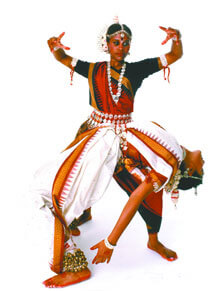South Asian festival features queer-infused performance
In the early 19th century, British colonial administrators in India passed laws banning classical Indian dance. Odissi, one form of dance, had been performed for centuries, but the British regarded it as deviant, primarily because the female performers were associated with prostitution. The dance got driven underground.
Then, the only people permitted to practice Odissi in public were young boys, called “gotipuas,” who dressed as women for their performances.
After its independence from Britain some 50 years ago, Indian dancers of both sexes performed Odissi, but the dance maintains and celebrates this curious––call it queer––history of Westerners policing Indian sexuality and a cadre of “trans” performers persisting in keeping alive a cultural phenomenon.
Currently, a New York-based, all-female dance company is reinterpreting Odissi for North American audiences. In its current season, Nayikas Dance Theater Company presents “Samita the Infinite Within” through February 9 at Baruch College’s new performing art center. The repertoire, part of “Mela,” a month-long festival of South Asian culture, explores themes of sexuality and androgyny in Hindu mythology.
“In every piece, we are questioning what is defined as feminine, what is good,” said founder and artistic director Myna Mukherjee. “I believe this dance, all performance, serves a purpose––it can disturb, it can get under people’s skin.”
The show’s choreography has an insistent theatricality. The dancers, in matching costume and arresting face paint, move in kaleidoscopic formations around the space. The dramatic tension inherent in the tension surrounding the characters and the roles in which they are confined informs the performances.
For example, “Faces of a Name,” a fairy tale-like drama, is a piece describing an androgynous warrior-princess who gives up her masculine side to appeal to a suitor, but in the end reassumes her split-gendered self.
These works weave dance and play-acting. In addition to musical accompaniment, the occasional taped dramatic monologue narrates the movement. Through sound, sight and even smell, the performances never allow the audience’s sensory involvement to lapse.
At one point, dancers take to the floor with stalks of burning incense in hand, making Baruch’s Nagelberg Theater into a temple to Lord Jagganath, the deity of whom Odissi’s female dancers in antiquity were devotees.
The lighting director executes brilliant washes of bright red and burnt orange colors that bathe the dancers in exotic light.
Nayikas is the only American ensemble dedicated to performing Odissi. While remaining true to that form, the company does reference other disciplines, such as jazz, ballet and modern, as its members express onstage in their performances.
Anurima Banerji, a Nayikas dancer, has trained in Odissi since childhood, but the lack of performance venues has interrupted the consistency in her practice.
“I’d always wanted to be part of a space in North America dedicated to the Odissi ethos,” said Banerji, whose current graduate work in the department of performance studies at New York University focuses on classical Indian dance. “Here, with Nayikas, we are able to even further expand the boundaries of the dance.”
With its sensual themes and overt body contact, Nayikas’ choreography challenges the way Odissi is traditionally practiced.
“In classical Indian dance, nobody touches anybody,” says dancer Sunonda Samaddar, who has trained in Odissi for more than 20 years. “We [in Nayikas] touch, we hold, we do things you would never see done in India.”
The company, though composed primarily of dancers of South Asian descent, has in its short history included male performers as well as dancers of other ethnicities, said Mukherjee.
The production both casts and trawls a wide net. At one night’s performance, attendees ran the gamut from the highly regarded author Salman Rushdie to the street-credentialed Bhangra deejay, Rekha.
“We are very quietly breaking down barriers,” Mukherjee said. “Heritage is important, but unless you infuse it with what is happening to you today, it’s all dead.”


































